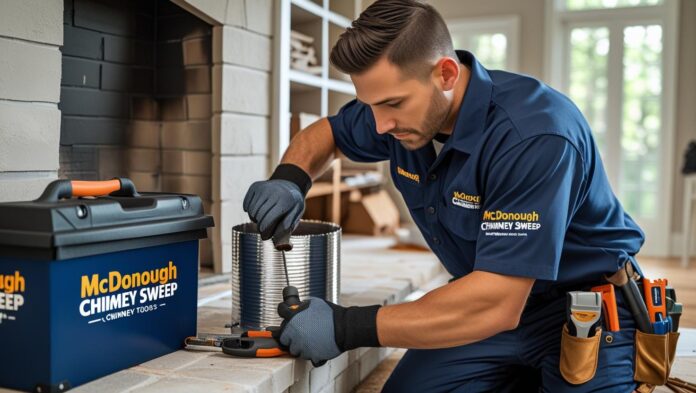When chilly winds start swirling around McDonough, there’s nothing quite like the comfort of gathering near a cozy fireplace. But as you get ready for those crackling fires, it’s smart to think about what you can’t see inside your chimney. Planning ahead now—before winter’s in full swing—could save you from headaches later. One of the most important but often overlooked upgrades is adding a chimney liner.
Hidden Dangers in an Unlined Chimney
Most people never really peek into their chimneys. Out of sight, out of mind, right? But inside that dark stack, years of heat, smoke, and soot can do some sneaky damage. If the inside walls of your chimney aren’t properly lined, hot gases and even tiny embers can work their way through cracks in the bricks. Over time, this can lead to some pretty scary problems—like fires inside your walls or dangerous fumes sneaking back into your living room.
Chimney liners act like a safety shield. They create a smooth, solid channel that helps smoke and gases travel safely up and out. Without this protection, all that heat and residue can eat away at the mortar, eventually leaving gaps where trouble can start. Think of it like wearing a good pair of boots before trudging through mud—you need that extra layer to keep everything safe and sound.
Boosting Efficiency and Saving Money
Have you ever noticed your fire just isn’t burning as well as it used to, or maybe the room never seems to get quite as warm? Sometimes, the problem isn’t with your fireplace, but with the chimney itself. A liner helps your fireplace or wood stove work better by guiding hot air and smoke up and out, instead of letting it swirl around or leak into your house.
With a proper liner, your fire burns steadier, and you use less wood or fuel to get the same warmth. That means you’re not only making your home safer, but you’re also keeping more cash in your wallet when those heating bills arrive.
| Benefit | Without Chimney Liner | With Chimney Liner |
|---|---|---|
| Fire Safety | Higher risk of chimney or house fires | Greatly reduced fire risk |
| Heating Efficiency | Heat loss, poor draft | More heat stays in your home |
| Air Quality | Possible backdraft of smoke and gases | Cleaner, healthier indoor air |
| Chimney Lifespan | Faster wear and tear | Longer-lasting chimney structure |
Meeting Local Codes (and Insurance, Too!)
Here in McDonough, building codes and insurance requirements change from time to time, but one thing stays the same: they’re always focused on safety. Many home insurance companies won’t cover chimney-related damage if you don’t have a liner. Plus, if you ever sell your home, a lined chimney can help you pass inspections without a hitch.
If your home is older or you’ve never thought about your chimney before, you might not realize you’re missing this important feature. Getting a liner installed before winter starts is a smart move that keeps you ahead of the game and off the insurance company’s “naughty list.”
Winter is Coming—Don’t Wait Until It’s Too Late
Maybe you’re thinking, “I’ll wait until next year.” But winter weather can sneak up quickly in Georgia, and chimney pros get busy fast when the cold sets in. If you put off installing a liner, you might end up waiting weeks for a technician while cold air seeps inside, or worse, you could be forced to skip using your fireplace altogether.
Taking care of your chimney before the first frost means you can enjoy every snowflake and chilly night, knowing your home is safe, warm, and ready for whatever the season throws your way.
Wrapping Up: A Cozy, Worry-Free Winter Awaits
At the end of the day, installing a chimney liner isn’t just about following the rules or ticking off a box on your home maintenance list. It’s about keeping your loved ones safe, saving money on your energy bills, and truly enjoying those quiet winter nights by the fire. Don’t wait until you’re shivering and wishing you’d planned ahead. This year, give yourself the gift of peace of mind with a brand new chimney liner—you’ll be glad you did when the first fire of the season lights up your hearth.
Read more : Chimney Sweep

















